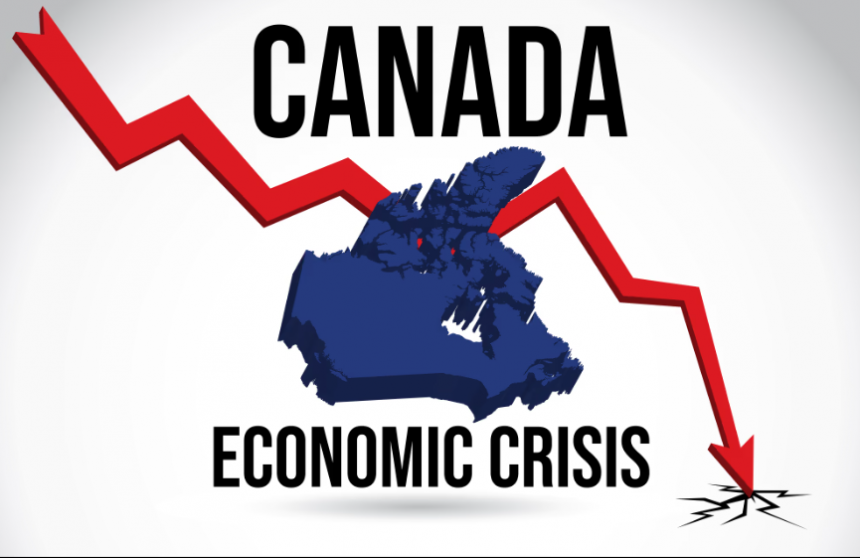1. Introduction — A Fragile Landscape
Canada, long seen as a stable advanced economy, is now grappling with mounting headwinds: slowing growth, trade tensions, rising debt burdens, and weakening confidence. What was once considered a “mild soft patch” is increasingly viewed by many economists as a structural crisis in the making.
According to Statistics Canada, in early 2025, the Canadian economy was already contracting in parts, and business sentiment flagged sharply. Статистика Канады The OECD Economic Surveys: Canada 2025 argues that while population growth has propped up headline GDP, per capita growth remains weak, and elevated household debt is constraining consumption. OECD
Meanwhile, Bank of Canada’s Financial Stability Report 2025 warns that a sustained global trade war could push Canada into a year-long recession, with unemployment rising and inflation temporarily spiking over 3 %. Банк Канады
This crisis is not just cyclical — it combines structural, external, and domestic pressures. Below we explore drivers, impacts, and possible pathways forward.
2. Key Drivers of the Crisis
a) Trade Pressures & U.S. Tariffs
Canada’s economy is heavily tied to U.S. trade: when the U.S. imposes tariffs or threatens stricter trade measures, Canadian exporters and supply chains feel the strain almost immediately.
In early 2025, new U.S. tariffs on Canadian imports sparked retaliation and widespread anxiety among businesses. Reuters notes that these trade shocks threaten to derail Canada’s fragile recovery. Reuters
The OECD report highlights that since February 2025, escalating tariffs have weighed heavily on exports and investor confidence. OECD
In its Quarterly Economic Forecast, TD Economics projects that Canada’s growth might slow to just ~1.2 % in 2025 due to the drag from trade barriers. TD Экономика
b) Weak Business Investment & Productivity Slump
Over a long stretch, business investment in Canada has been sluggish. The OECD report points out that firms have not sufficiently reinvested post-COVID, hurting productivity growth. OECD
This matters because with rapid population growth, maintaining output per worker is crucial. But with weak investment, the gains per capita are minimal — a long-standing drag on living standards. OECD+1
c) Elevated Household Debt & Consumer Strain
Canadian households carry high levels of debt. This means that when economic conditions soften, many are unable to reduce spending dramatically or service additional borrowing. The OECD warns that higher debt service costs are already eating into disposable income. OECD
Consumer confidence sagged in spring 2025, and many households pulled back on discretionary purchases. РБК+1
d) Regional Divergences & Sectoral Weakness
Not all provinces or sectors are affected equally. Export-oriented and manufacturing provinces such as Ontario and Quebec are under heavier pressure. In contrast, resource-rich provinces (e.g. Alberta, Saskatchewan) have some buffer thanks to energy and commodity revenues. The Hub
Manufacturing seems especially fragile: since early 2025, factories have shed tens of thousands of jobs — part of a broader industrial slowdown. The Hub
e) Structural Factors: Population Growth & Productivity Ceiling
A paradox is that while Canada is seeing relatively strong population growth, this influx is diluting per capita gain. The OECD notes that much of the headline GDP growth owes to population expansion, not real productivity improvements. OECD
The Fraser Institute in earlier analysis argues that Canada has long suffered from stagnation in GDP per person; over a multi-year span (2022–2023), real per capita GDP actually fell ~3.4 % in inflation-adjusted terms. Fraser Institute
So the structural ceiling on how fast the economy can grow is lower than many expect.
3. Recent Performance & Warning Signs
Q1 2025: A Mixed Start
Canada’s GDP in the first quarter of 2025 grew ~0.5 % (annualized ~2.2 %), largely driven by exporters pulling forward orders ahead of tariffs. The Real Economy Blog
However, this growth was deceptive: momentum faded in consumer spending, and many firms built up inventories in anticipation of tariff disruptions. The Real Economy Blog
There is widespread expectation that Q2, Q3 may face contraction unless trade tensions ease.
Sentiment & Confidence Indices
Business sentiment collapsed in spring, and Fitch Ratings highlighted that the sharp decline suggests deep cuts in investment are likely. Fitch Ratings
The Hub reports that consumer confidence has rebounded somewhat from its lows, but the environment remains unstable. The Hub
Warning from the Central Bank
The Bank of Canada’s Financial Stability Report models a scenario in which sustained external pressures push Canada into recession, with strains on borrowers, liquidity, and credit defaults. Банк Канады
Also, in its Monetary Policy Report, the Bank emphasizes that monetary policy alone may not be enough to counterbalance structural and trade headwinds. Банк Канады+1
4. Impacts on Real Lives & Key Sectors
Unemployment & Labour Market
As demand softens and capital investment stalls, labor markets are under stress. Layoffs have been reported in manufacturing, and job vacancies are cooling. The Hub+2РБК+2
Wages are stagnating relative to inflation, putting pressure on middle and lower income households.
Housing & Real Estate Markets
Canada had already been flagged for an overheated housing sector. The Canadian property bubble article notes that the housing stock value relative to GDP is very high and risk of mortgage defaults is elevated among advanced economies. Википедия
With weakening incomes, higher interest rates, and softer demand, many markets are cooling, especially in costly metropolitan regions.
Corporate & Business Defaults
If trade pressures intensify, firms with high leverage or narrow profit margins might default. The Bank’s scenario modeling warns that credit stress could cascade. Банк Канады
Smaller businesses are especially vulnerable, particularly those in export, manufacturing, and supply chain sectors.
Government Revenues & Fiscal Pressure
Falling corporate profits, weaker consumption, and slower growth erode tax bases. Meanwhile, governments still must service debt obligations and fund social programs.
However, Canada’s public finances remain relatively strong, giving the government some fiscal leeway to intervene. The OECD says this is a strategic asset in coming times. OECD
Social & Regional Strains
Regions dependent on heavy industry or exports may see sharper declines. Social inequality could widen. In weaker provinces, public services may feel stress as tax revenues shrink.
5. What Can Canada Do? Policy Options & Risks
Monetary Policy & Interest Rates
The Bank of Canada may further ease rates if conditions worsen, but its room is limited by inflationary risk. Current rates had been trimmed to ~2.75 %. OECD+2TD Экономика+2
Cutting rates further risks fueling asset bubbles and weakening the currency, but failing to act may deepen recession.
Fiscal Stimulus & Strategic Investment
Given healthier public finances, federal and provincial governments can deploy targeted stimulus — e.g. infrastructure, clean energy, R&D — to boost growth and job creation.
However, stimulus must be well-targeted. Wasteful spending or misallocation could worsen long-term debt burdens.
Trade Diplomacy & Diversification
One of the strongest levers is mitigating trade risk. Canada should deepen trade with non-U.S. partners, renegotiate supply chain linkages, and push for tariff relief.
Reducing dependency on a single market (the U.S.) is critical. The OECD suggests Canada must push competition, reduce internal trade barriers, and align business environment with growth needs. OECD
Boosting Productivity & Innovation
Long term recovery hinges on productivity growth. Policies to encourage innovation, digital adoption, workforce upskilling, and greater competition are essential. The OECD emphasizes that Canadian productivity lags peers. OECD
Debt Resilience & Regulation
Regulators must monitor credit risk in households and firms, ensure banking system resilience, and preempt liquidity stress. The Bank’s Financial Stability Report stresses vigilance. Банк Канады
Governments may need to reassess tax structure — shifting burdens from income to consumption or environmental levies to better support growth. OECD
6. Outlook & Scenarios
- Base Case: Canada enters a mild recession in 2025 (zero to modest contraction), then stabilizes late in the year if trade tensions ease and stimulus kicks in.
- Downside Risk: A prolonged U.S.–Canada trade conflict could push Canada into a deeper, drawn-out recession. In this scenario, corporate defaults rise, unemployment surges, and fiscal strains accumulate. The Bank’s scenario warns of exactly that. Банк Канады
- Upside (Hopeful) Case: Targeted policy action, trade reprieve, reforms, and global stabilization could allow Canada to avoid a full contraction, though growth would remain weak.
In any case, the structural challenges Canada faced before 2025 (weak per capita growth, productivity drag) mean recovery may be slower and bumpier than in past cycles.
7. Conclusion
Canada’s 2025 economic environment showcases a confluence of cyclical shock and structural strain. Trade pressures, weak investment, high debt, regionally uneven stress, and subdued productivity all combine to elevate down-side risks. The tools exist for mitigation — fiscal firepower, policy reforms, trade diplomacy — but success depends on nimble and credible execution.
The coming months will test whether Canada can steer through this crisis or succumb to deeper economic malaise.












